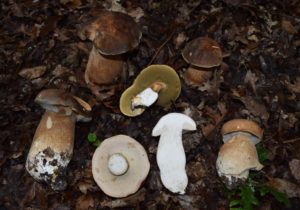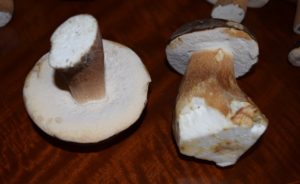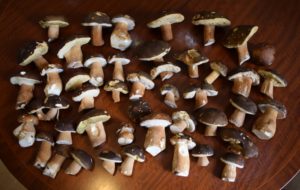Email: geoff@geoffdann.co.uk
30/08/2018
An update is required! Having blogged a couple of days ago about finding lots of large boletes but no Dark Penny Buns (Boletus aereus), today I came across a bonanza of them. I also saw quite a lot of the other things I described as “missing” in that post – plenty of Brittlegills and Milkcaps, Leccinums and Suillus coming through, as well as a lot of poisonous Livid Pinkgills (Entoloma sinuatum). And gazillions of Blushers.
I had originally tried a spot I’ve seen them before. I found one specimen, rolling around loose having been knocked over by an animal. So I decided to check somewhere else that I’ve previously seen Chestnut Boletes. There were none (but quite a lot of other stuff). Then I headed off home via a different route and was really excited to find about 15 Dark Penny Buns – more than I’d ever found in one place before, and in good enough condition to get a much better ID photo than my existing best one. I was very happy with my afternoon’s work.
Then about 50 metres away I came across the motherlode. Well over 200 of them growing under a row of oaks I have passed countless times before, but never seen any of this species. I do sometimes criticise people for irresponsible “over-picking”, but this was one of those situations where this was almost impossible. Firstly, there was no shortage of large, old specimens which weren’t worth picking, because they were too soft and grub-infested.
So I was only interested in the youngsters, and most of these were at the early stages of infection with “Bolete Eater” mould, which means that within a day or two they were destined to become both inedible and infertile.
And since nobody else forages in this location (almost nobody else even goes there – it is rather inaccessible, the footpath into it is poorly marked and doesn’t go anywhere sensible. I’ve never even seen a dog-walker there, just the occasional horse rider) I figured I’d take as many as I could carry!
This is the biggest mass-fruiting of one of the big edible prized boletes I have ever seen in one place at one time.
It’s looking good. Let’s hope it stays this way, and 2018 could be a classic mushroom year.
Edit: I found another huge flush a few days later, video here.





At first glance I’d have taken your collection to be rather stout specimens of the much commoner bay bolete B. badius – but it seems that in B. aereus the flesh does *not* turn blue – is that right? We made a substantial collection of B. badius yesterday: it’s possible that one or two B. aereus crept in by mistake! Since they’re all now trimmed and prepared for today’s lunch, hard to tell – although I think they all turned somewhat blue during slicing – so mine are almost certainly all bay boletes.
Anyway it looks like a predominantly Medierranean species is migrating north. No surprise there, what with global warming!
Yes, bay boletes bruise clearly blue in the pores and dark penny buns don’t turn blue at all. They are also more slender and smell different.